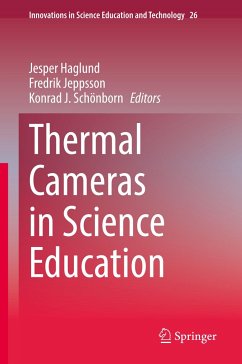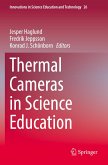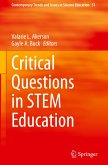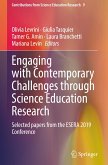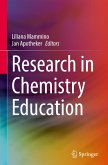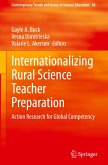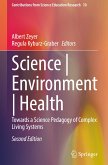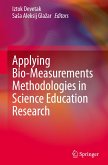Thermal Cameras in Science Education
Herausgegeben:Haglund, Jesper; Jeppsson, Fredrik; Schönborn, Konrad J.
Thermal Cameras in Science Education
Herausgegeben:Haglund, Jesper; Jeppsson, Fredrik; Schönborn, Konrad J.
- Gebundenes Buch
- Merkliste
- Auf die Merkliste
- Bewerten Bewerten
- Teilen
- Produkt teilen
- Produkterinnerung
- Produkterinnerung
This book presents a collection of educational research and developmental efforts on the rapidly emerging use of infrared cameras and thermal imaging in science education. It provides an overview of infrared cameras in science education to date, and of the physics and technology of infrared imaging and thermography. It discusses different areas of application of infrared cameras in physics, chemistry and biology education, as well as empirical research on students' interaction with the technology. It ends with conclusions drawn from the contributions as a whole and a formulation of forward-looking comments. …mehr
Andere Kunden interessierten sich auch für
![Thermal Cameras in Science Education Thermal Cameras in Science Education]() Thermal Cameras in Science Education117,99 €
Thermal Cameras in Science Education117,99 €![Critical Questions in STEM Education Critical Questions in STEM Education]() Critical Questions in STEM Education139,09 €
Critical Questions in STEM Education139,09 €![Engaging with Contemporary Challenges through Science Education Research Engaging with Contemporary Challenges through Science Education Research]() Engaging with Contemporary Challenges through Science Education Research121,99 €
Engaging with Contemporary Challenges through Science Education Research121,99 €![Research in Chemistry Education Research in Chemistry Education]() Research in Chemistry Education81,99 €
Research in Chemistry Education81,99 €![Internationalizing Rural Science Teacher Preparation Internationalizing Rural Science Teacher Preparation]() Internationalizing Rural Science Teacher Preparation113,99 €
Internationalizing Rural Science Teacher Preparation113,99 €![Science Environment Health Science Environment Health]() Science Environment Health105,99 €
Science Environment Health105,99 €![Applying Bio-Measurements Methodologies in Science Education Research Applying Bio-Measurements Methodologies in Science Education Research]() Applying Bio-Measurements Methodologies in Science Education Research81,99 €
Applying Bio-Measurements Methodologies in Science Education Research81,99 €-
-
-
This book presents a collection of educational research and developmental efforts on the rapidly emerging use of infrared cameras and thermal imaging in science education. It provides an overview of infrared cameras in science education to date, and of the physics and technology of infrared imaging and thermography. It discusses different areas of application of infrared cameras in physics, chemistry and biology education, as well as empirical research on students' interaction with the technology. It ends with conclusions drawn from the contributions as a whole and a formulation of forward-looking comments.
Produktdetails
- Produktdetails
- Innovations in Science Education and Technology 26
- Verlag: Springer / Springer International Publishing / Springer, Berlin
- Artikelnr. des Verlages: 978-3-030-85287-0
- 1st edition 2022
- Seitenzahl: 224
- Erscheinungstermin: 16. März 2022
- Englisch
- Abmessung: 241mm x 160mm x 17mm
- Gewicht: 547g
- ISBN-13: 9783030852870
- ISBN-10: 3030852873
- Artikelnr.: 62246498
- Herstellerkennzeichnung Die Herstellerinformationen sind derzeit nicht verfügbar.
- Innovations in Science Education and Technology 26
- Verlag: Springer / Springer International Publishing / Springer, Berlin
- Artikelnr. des Verlages: 978-3-030-85287-0
- 1st edition 2022
- Seitenzahl: 224
- Erscheinungstermin: 16. März 2022
- Englisch
- Abmessung: 241mm x 160mm x 17mm
- Gewicht: 547g
- ISBN-13: 9783030852870
- ISBN-10: 3030852873
- Artikelnr.: 62246498
- Herstellerkennzeichnung Die Herstellerinformationen sind derzeit nicht verfügbar.
Jesper Haglund is a senior lecturer in physics education at Karlstad University, Sweden. He gained his PhD in science education in 2012 at Linköping University, and was appointed docent in physics with specialization in physics education at Uppsala University in 2016. Haglund's research has focused on how analogies and metaphors, and visualization technology can be used to support students' learning, in particular within thermal science. Fredrik Jeppsson is associate professor in science education at Linköping University, Sweden. He gained his PhD in science education in 2012 at Linköping University. Jeppsson's research has focused mainly on how language-based resources and visualization technology can be used to support students' learning in the science classroom, in particular within thermal science. Konrad J. Schönborn is a professor of visual learning and communication at Linköping University, Sweden. He is scientific leader ofthe Swedish National Graduate School in Science and Technology Education (FontD), and is a Member of the Royal Society of Biology (MRSB). His research explores the role of visualization, visual literacy, multimodality, and virtual environments in STEM education.
Part I: Thermal imaging technology and setups for measurement and application.- Chapter 1 Introduction to the physics of thermal radiation and technology of thermal imaging; Michael Vollmer and Klaus-Peter Möllmann.- Chapter 2 Comparison of IR camera data with theoretical models of heat conduction; Stefano Oss and Giuliano Zendri.- Chapter 3 virtual reality, augmented reality, and mixed reality in infrared light; Charles Xie.- Chapter 4 framing infrared cameras as technology in science education laboratory practice and a practical guide to introducing infrared cameras in science education teaching and research; Jesper Haglund, Fredrik Jeppsson and Konrad Schönborn.- Part II: Science education research on the use of infrared cameras.- Chapter 5 Seeing what they saw: Assessing student learning by analyzing point-of-view thermal videos; Charles Xie.- Chapter 6 physics activities in secondary teaching; Jeff Nordine and Susanne Wessnigk.- Chapter 7 pupils' affective responseto using IR cameras; Anni Loukomies, Kalle Juuti and Jari Lavonen.- Chapter 8 social semiotics analysis of pupils' practical work with IR cameras; Niklas Åhman and Fredrik Jeppsson.- Chapter 9 introduction of IR cameras as a digital technology in preschool; Jeanni Flognman, Janni Karlsson and Jesper Haglund.- Part III: Using infrared cameras in the science teaching practice.- Chapter 10 school activities with visible, near-IR and far-IR light from the MUSE project; Gorazd Planinsic and Eugenia Etkina.- Chapter 11 investigation of electromagnetic radiation and electric circuits with IR cameras; Chuon Wong and R Subramaniam.- Chapter 12 using IR cameras in chemistry education; Xinhua Xu, Meifen Wu and Xiaogang Wang.- Chapter 13 use of infrared camera in medical education; Urban Eriksson and Nina Reistad.- Chapter 14 introduction of IR cameras in physics teaching in a South African township setting; Gilbert Dolo, Leon Grové, Jesper Haglund, and Konrad Schönborn.- Chapter 15 introduction of IR cameras in science centre activities; Karljohan Lundin Palmerius, Andreas Larsson, and Schönborn.
Part I: Thermal imaging technology and setups for measurement and application.- Chapter 1 Introduction to the physics of thermal radiation and technology of thermal imaging; Michael Vollmer and Klaus-Peter Möllmann.- Chapter 2 Comparison of IR camera data with theoretical models of heat conduction; Stefano Oss and Giuliano Zendri.- Chapter 3 virtual reality, augmented reality, and mixed reality in infrared light; Charles Xie.- Chapter 4 framing infrared cameras as technology in science education laboratory practice and a practical guide to introducing infrared cameras in science education teaching and research; Jesper Haglund, Fredrik Jeppsson and Konrad Schönborn.- Part II: Science education research on the use of infrared cameras.- Chapter 5 Seeing what they saw: Assessing student learning by analyzing point-of-view thermal videos; Charles Xie.- Chapter 6 physics activities in secondary teaching; Jeff Nordine and Susanne Wessnigk.- Chapter 7 pupils' affective responseto using IR cameras; Anni Loukomies, Kalle Juuti and Jari Lavonen.- Chapter 8 social semiotics analysis of pupils' practical work with IR cameras; Niklas Åhman and Fredrik Jeppsson.- Chapter 9 introduction of IR cameras as a digital technology in preschool; Jeanni Flognman, Janni Karlsson and Jesper Haglund.- Part III: Using infrared cameras in the science teaching practice.- Chapter 10 school activities with visible, near-IR and far-IR light from the MUSE project; Gorazd Planinsic and Eugenia Etkina.- Chapter 11 investigation of electromagnetic radiation and electric circuits with IR cameras; Chuon Wong and R Subramaniam.- Chapter 12 using IR cameras in chemistry education; Xinhua Xu, Meifen Wu and Xiaogang Wang.- Chapter 13 use of infrared camera in medical education; Urban Eriksson and Nina Reistad.- Chapter 14 introduction of IR cameras in physics teaching in a South African township setting; Gilbert Dolo, Leon Grové, Jesper Haglund, and Konrad Schönborn.- Chapter 15 introduction of IR cameras in science centre activities; Karljohan Lundin Palmerius, Andreas Larsson, and Schönborn.

